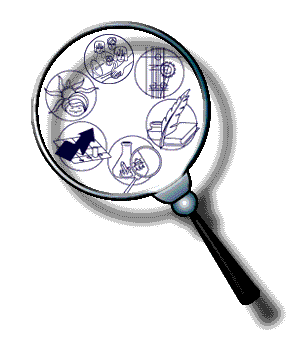
 |
5 definitions found
From The Collaborative International Dictionary of English v.0.48 [gcide]:
Ion \I"on\ ([imac]"[o^]n), n. [Gr. 'io`n, neut, of 'iw`n, p. pr.
of 'ie`nai to go.]
1. (Elec. Chem.) an atom or goup of atoms (radical) carrying
an electrical charge. It is contrasted with neutral atoms
or molecules, and free radicals. Certain compounds, such
as sodium chloride, are composed of complementary ions in
the solid (crystalline) as well as in solution. Others,
notably acids such as hydrogen chloride, may occur as
neutral molecules in the pure liquid or gas forms, and
ionize almost completely in dilute aqueous solutions. In
solutions (as in water) ions are frequently bound
non-covalently with the molecules of solvent, and in that
case are said to be solvated. According to the
electrolytic dissociation theory, the molecules of
electrolytes are divided into ions by water and other
solvents. An ion consists of one or more atoms and carries
one unit charges of electricity, 3.4 x 10^{-10}
electrostatic units, or a multiple of this. Those which
are positively electrified (hydrogen and the metals) are
called {cations}; negative ions (hydroxyl and acidic atoms
or groups) are called {anions}.
Note: Thus, hydrochloric acid ({HCl}) dissociates, in aqueous
solution, into the hydrogen ion, {H+}, and the chlorine
ion, {Cl-}; ferric nitrate, {Fe(NO3)3}, yields the
ferric ion, {Fe+++}, and nitrate ions, {NO3-}, {NO3-},
{NO3-}. When a solution containing ions is made part of
an electric circuit, the cations move toward the
cathode, the anions toward the anode. This movement is
called migration, and the velocity of it differs for
different kinds of ions. If the electromotive force is
sufficient, electrolysis ensues: cations give up their
charge at the cathode and separate in metallic form or
decompose water, forming hydrogen and alkali;
similarly, at the anode the element of the anion
separates, or the metal of the anode is dissolved, or
decomposition occurs. Aluminum and chlorine are
elements prepared predominantly by such electrolysis,
and depends on dissolving compounds in a solvent where
the element forms ions. Electrolysis is also used in
refining other metals, such as copper and silver. Cf.
{Anion}, {Cation}.
[Webster 1913 Suppl.]
2. One of the small electrified particles into which the
molecules of a gas are broken up under the action of the
electric current, of ultraviolet and certain other rays,
and of high temperatures. To the properties and behavior
of ions the phenomena of the electric discharge through
rarefied gases and many other important effects are
ascribed. At low pressures the negative ions appear to be
electrons; the positive ions, atoms minus an electron. At
ordinary pressures each ion seems to include also a number
of attached molecules. Ions may be formed in a gas in
various ways.
[Webster 1913 Suppl.]
From The Collaborative International Dictionary of English v.0.48 [gcide]:
Symbol \Sym"bol\ (s[i^]m"b[o^]l), n. [L. symbolus, symbolum, Gr.
sy`mbolon a sign by which one knows or infers a thing, from
symba`llein to throw or put together, to compare; sy`n with +
ba`llein to throw: cf. F. symbole. Cf. {Emblem}, {Parable}.]
1. A visible sign or representation of an idea; anything
which suggests an idea or quality, or another thing, as by
resemblance or by convention; an emblem; a representation;
a type; a figure; as, the lion is the symbol of courage;
the lamb is the symbol of meekness or patience.
[1913 Webster]
A symbol is a sign included in the idea which it
represents, e. g., an actual part chosen to
represent the whole, or a lower form or species used
as the representative of a higher in the same kind.
--Coleridge.
[1913 Webster]
2. (Math.) Any character used to represent a quantity, an
operation, a relation, or an abbreviation.
[1913 Webster]
Note: In crystallography, the symbol of a plane is the
numerical expression which defines its position
relatively to the assumed axes.
[1913 Webster]
3. (Theol.) An abstract or compendium of faith or doctrine; a
creed, or a summary of the articles of religion.
[1913 Webster]
4. [Gr. ? contributions.] That which is thrown into a common
fund; hence, an appointed or accustomed duty. [Obs.]
[1913 Webster]
They do their work in the days of peace . . . and
come to pay their symbol in a war or in a plague.
--Jer. Taylor.
[1913 Webster]
5. Share; allotment. [Obs.]
[1913 Webster]
The persons who are to be judged . . . shall all
appear to receive their symbol. --Jer. Taylor.
[1913 Webster]
6. (Chem.) An abbreviation standing for the name of an
element and consisting of the initial letter of the Latin
or New Latin name, or sometimes of the initial letter with
a following one; as, {C} for carbon, {Na} for sodium
(Natrium), {Fe} for iron (Ferrum), {Sn} for tin (Stannum),
{Sb} for antimony (Stibium), etc. See the list of names
and symbols under {Element}.
[1913 Webster]
Note: In pure and organic chemistry there are symbols not
only for the elements, but also for their grouping in
formulas, radicals, or residues, as evidenced by their
composition, reactions, synthesis, etc. See the diagram
of {Benzene nucleus}, under {Benzene}.
[1913 Webster]
Syn: Emblem; figure; type. See {Emblem}.
[1913 Webster]
From WordNet (r) 2.0 [wn]:
Fe
n : a heavy ductile magnetic metallic element; is silver-white
in pure form but readily rusts; used in construction and
tools and armament; plays a role in the transport of
oxygen by the blood [syn: {iron}, {atomic number 26}]
From Virtual Entity of Relevant Acronyms (Version 1.9, June 2002) [vera]:
FE
Forschung und Entwicklung, "F&E"
From Virtual Entity of Relevant Acronyms (Version 1.9, June 2002) [vera]:
FE
Functional Entity (IN)
Powered by Blog Dictionary [BlogDict]
Kindly supported by
Vaffle Invitation Code
Get a Freelance Job - Outsource Your Projects | Threadless Coupon
All rights
reserved. (2008-2024)